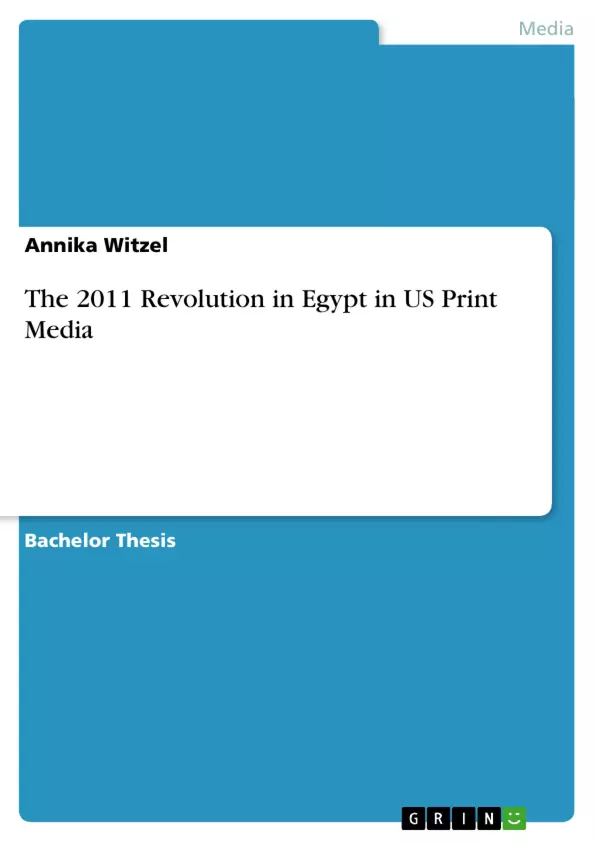“Lotus Revolution” (Egypt State Information Service1), “18-Day Revolution”
(Armbruster 2011), “Nile Revolution” (Murdock February 8, 2011), “Facebook
Revolution” (Herrera February 12, 2011) – what happened in Egypt at the beginning of
2011 was given many different titles. Some even call it “the most unexpected
development in modern Egyptian history” (Sharp 2011b: 2). After 18 days of protests
in Cairo and other cities all over Egypt, the Egyptian people made their President
Hosni Mubarak resign. He had been ruling the country for almost 30 years and his
people wanted to get rid of him and his regime. That was their goal and that is what
they achieved.
Of course there were international reactions to the uprisings from all over the
world. “Numerous press reports […] have recounted feelings of popular empowerment
and pride inspired by the exploits of Egypt’s young protesters” (Sharp 2011b: 5).
During the revolution, European leaders urged “Egypt’s transition to a new
government” at the beginning of February (Murdock February 4), while China blocked
the word “Egypt” from a twitter-like micro blogging website, according to Associated
Press (quoted by Al Jazeera 2011).Further, when considering recent developments in
Libya and Syria, other Middle Eastern countries seem to be inspired by the revolutions
in both Tunisia and Egypt. After Mubarak had stood down on February 11, the
reactions were even stronger – “Today, we are all Egyptians”, stated Norwegian Prime
Minister Jens Stoltenberg and David Cameron suggested “We should teach the
Egyptian revolution in our schools” (ESIS 2011).
However, the United States seem to keep a particularly eager eye on the most
populous country of the Middle East. Souad Mekhennet, New York Times and ZDF
correspondent, states in an interview with the German medium magazine that
“curiously, the American media reacted much faster than the European” when it comes
to reporting about the Egyptian revolution (Milz 2011: 20). Moreover, she adds that the
large US media outlets’ reporting on the topic is “much more continuous and broader”
(ibid.), giving a lot more background information on the region. This special attention
is most likely due to the fact that for the United States, Egypt is a highly important
actor when it comes to foreign policy in the region. [...]
Inhaltsverzeichnis (Table of Contents)
- Introduction
- The 2011 Egyptian revolution
- The papers
- Methodology
- Analysis
- Editorial
- The Wall Street Journal
- New York Times
- San Francisco Chronicle
- The Washington Times
- Conclusion
- News story
- The Wall Street Journal
- New York Times
- San Francisco Chronicle
- The Washington Times
- Conclusion
- Letter to the Editor
- The Wall Street Journal
- New York Times
- San Francisco Chronicle
- The Washington Times
- Conclusion
- Editorial
Zielsetzung und Themenschwerpunkte (Objectives and Key Themes)
This paper investigates the depiction of the 2011 Egyptian revolution in four American newspapers, focusing on the potential for political bias in their reporting. It seeks to answer the following questions:- How did the US print media depict the 2011 revolution in Egypt?
- Are there any differences in reporting within the media landscape?
- Political bias in the US media
- The role of the United States in the Middle East
- The influence of the Muslim Brotherhood
- The challenges of journalistic objectivity
- The impact of the revolution on regional stability
Zusammenfassung der Kapitel (Chapter Summaries)
The introduction provides context for the Egyptian revolution of 2011 and sets out the research questions and methodology. The paper will examine how four American newspapers – The Wall Street Journal, the New York Times, the San Francisco Chronicle, and The Washington Times – reported on the revolution. The introduction also discusses the importance of Egypt to US foreign policy and highlights the potential for bias in Western media coverage of the Middle East.
The analysis section examines the editorial, news story, and letter-to-the-editor sections of each newspaper. It explores the varying perspectives, framing, and language used by each outlet in their coverage of the revolution. This section will delve into the different approaches adopted by each newspaper to report on the events, identifying potential biases and offering insights into their journalistic practices.
Schlüsselwörter (Keywords)
This paper focuses on the analysis of US print media coverage of the 2011 Egyptian revolution. Key themes include political bias, journalistic objectivity, US foreign policy, the Muslim Brotherhood, and the impact of the revolution on regional stability. The analysis will investigate the media's portrayal of the revolution and the role of US interests in shaping the narrative.- Citar trabajo
- Annika Witzel (Autor), 2011, The 2011 Revolution in Egypt in US Print Media, Múnich, GRIN Verlag, https://www.grin.com/document/193278



